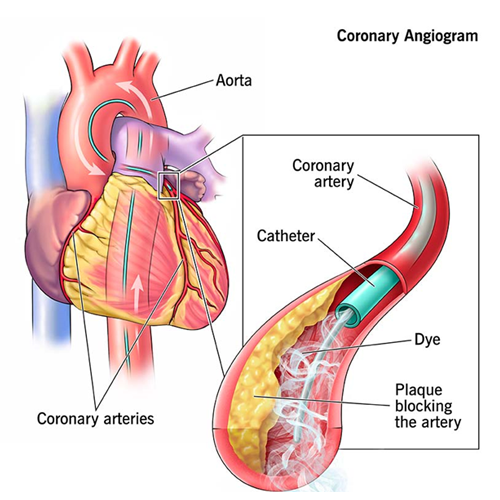Our heart is more than just a pumping organ – It stores our most intense feelings during life’s journey. However, it falters occasionally, raising red flags. At that point, medical professionals step in, offering Coronary Angiography to understand and treat it.
If you’re searching for the Coronary Angiography Hospital in Indore, trust experienced professionals who can compassionately guide you through your heart’s journey.
What is a Coronary Angiography?
Coronary Angiography is like embarking on a unique journey deep within the heart; it’s more than just a medical examination. Doctors examine the coronary arteries—the lifelines of the heart—using X-rays and dye. Consider it an important journey to the heart’s safety, led by the sure hands of knowledgeable healers. It’s a path full of promise that provides understanding and a means of regaining vitality and health.
When is a Coronary Angiography Performed?
A coronary angiography is done when your doctor suspects there might be a problem with your heart, like coronary artery disease (CAD) or other heart issues. It’s like a detective tool used in different situations, such as when your stress tests or Electrocardiograms (ECG) show irregularities, when you experience sudden chest pain before heart surgery, or when you have ongoing symptoms like chest pain or fatigue. It helps your medical team get a clear picture of your heart’s health and decide on the best course of action to keep you well.
Who Performs a Coronary Angiogram?
A coronary angiogram is typically conducted by an interventional cardiologist, a specialized physician adept at diagnosing and managing coronary artery disease and related cardiovascular conditions. These professionals possess the necessary expertise and precision to navigate the complex network of coronary arteries with accuracy.
At reputable coronary angiography center in Indore, heart specialist doctors provide comprehensive care, delivering precise diagnostics and personalized treatment plans to promote optimal heart health.
How does a Coronary Angiogram Work?
Imagine a tiny, flexible tube called a catheter, like a super-sleek straw, gently placed into an artery in your groin or wrist. With the help of special X-ray guidance, this catheter is carefully moved through your arteries until it reaches your heart’s blood vessels, called the coronary arteries.
Once the catheter is in position, a special dye is injected through it. This dye acts like a highlighter, making your coronary arteries show up clearly on X-ray images. This allows the doctors to see if there are any problems, like blockages caused by fatty deposits called plaques, which can make it harder for blood to flow through your arteries and reach your heart muscles.
How Do I Prepare for a Coronary Angiogram?
Preparing for a coronary angiogram involves several steps to ensure the procedure goes smoothly:
● Fasting: Patients are usually instructed to fast for several hours before the procedure to minimize the risk of complications.
● Medication Adjustments: Certain medications, such as anticoagulants and diabetes medications, may need to be adjusted or temporarily discontinued before the procedure.
● Medical History Review: Patients should provide detailed information about their medical history, including any allergies, previous reactions to contrast dye, and current medications.
What to Anticipate During Your Scheduled Coronary Angiogram Appointment:
● Duration: The coronary angiogram typically lasts 30 minutes to an hour, but it varies for each person. The medical team ensures your comfort throughout the procedure.
● Hospital Visit: If you’re not already at the hospital, you’ll need to come in for your appointment. It’s wise to plan for extra time just in case of unexpected delays.
● Potential Overnight Stay: While many can head home the same day, some might need to stay overnight for observation, especially if it’s later in the day.
● Preparation: Upon arrival, you’ll change into a comfy hospital gown and have a friendly chat with the medical team. They’ll ask about any past reactions to dye or medications you’re taking, ensuring your comfort and safety.
● Hygiene Consideration: Before the procedure begins, it’s best to use the restroom to avoid any discomfort during the angiogram. Your comfort matters to them.
What to Prepare for Throughout Your Coronary Angiogram Procedure:
● Positioning: As you prepare for the coronary angiogram, you’ll find yourself lying on your back, made as comfortable as possible by the medical team. They’ll ensure you receive medication to help you relax, allowing you to remain conscious throughout the procedure.
● Pain Management: The healthcare provider overseeing your angiogram will be vigilant about minimizing any discomfort you might experience during catheter insertion.
Catheter Insertion: With gentle care and precision, a thin tube will be guided into your artery, granting access to your coronary arteries. This step is crucial for obtaining the necessary images and information about the health of your heart.
● Contrast Dye Injection: Through the catheter, contrast dye will be injected into your bloodstream. This dye plays a vital role in making your coronary arteries visible on X-ray images, allowing the medical team to assess any blockages or narrowing.
● Monitoring: Throughout the procedure, your heart rhythm will be closely monitored using an electrocardiogram (ECG). This ensures that any irregularities or changes can be promptly addressed by the medical team.
● X-Ray Imaging: As the contrast dye travels through your arteries, X-ray images will be taken to provide a clear picture of your coronary arteries. These images are instrumental in identifying any blockages or narrowings that may be affecting your heart health. Rest assured, the medical team will guide you through each step with compassion and expertise, prioritizing your well-being every step of the way.
What to Look Forward to After Completing Your Coronary Angiogram Examination:
● Catheter Removal: After the coronary angiogram, the medical team removes the catheter and applies pressure to prevent bleeding, ensuring your safety.
● Observation Period: Depending on where the catheter was inserted, you may lie on your back for a few hours for monitoring and potential complication prevention.
● Discharge: Most patients can go home the same day, but some may stay overnight, especially if a stent was placed. Your provider decides based on your needs.
● Recovery: You may feel tired and sore at the insertion site, but these symptoms typically resolve within a week as your body heals.
● Activity Limitations: Your provider may suggest limiting activities for a couple of days post-procedure to aid in recovery.
Risks of a Coronary Angiogram:
While serious complications are rare, there are potential risks associated with the procedure, including low blood pressure, heart attack, stroke, and others. The best heart specialist doctor in Indore will discuss these risks with you beforehand.
By understanding what to expect and following your heart specialist’s instructions, you can prepare effectively for your coronary angiogram and ensure a safe and successful experience.
Understanding Your Coronary Angiogram Results:
After undergoing a coronary angiogram, the results can vary, impacting your heart health journey. Here’s a heart specialist, Dr. Indore, providing situations that you might encounter:
● Normal Results:
If your coronary angiogram shows no significant blockages or abnormalities in your coronary arteries, your healthcare provider will likely deem the results as normal. This means your heart is receiving adequate blood flow without any major obstructions.
● Abnormal Results:
Conversely, abnormal findings could indicate the presence of blockages, narrowing, or other issues within your coronary arteries. Your healthcare provider will carefully discuss these findings with you and suggest suitable treatment options based on the severity of the condition.
The Importance of Follow-Up Care:
Staying connected with your heart specialist doctor in Indore through regular follow-up appointments after a coronary angiogram is crucial for maintaining optimal heart health. These appointments provide valuable opportunities for your doctor to monitor your progress closely, adjust treatment plans as needed, and offer personalized guidance on lifestyle modifications to support your heart health journey.
By maintaining open communication and actively participating in your care, you can work collaboratively with your heart specialist doctor to address any concerns and ensure the best possible outcomes for your heart health.
Contact Us:
For Expert Coronary Angiography services in Indore, visit our state-of-the-art Coronary Angiography Center. Our experienced team provides comprehensive care and specialized treatment options tailored to your needs. Your heart’s health is our priority. Contact us today to schedule your consultation and experience unparalleled cardiac care.




